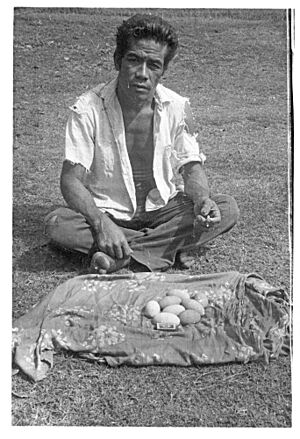Tongan megapode facts for kids
Quick facts for kids Tongan megapode |
|
|---|---|
 |
|
| Conservation status | |
| Scientific classification | |
| Genus: |
Megapodius
|
| Species: |
pritchardii
|
| Synonyms | |
|
|
The Tongan megapode (Megapodius pritchardii) is a special kind of bird that lives only on the islands of Tonga. It belongs to the megapode bird family, called Megapodiidae. This bird is also known as the Polynesian megapode or the Niuafo'ou megapode. It got the name Niuafo'ou because it lived on the island of Niuafo'ou for many years. The bird's scientific name honors a British consul named William Thomas Pritchard.
Where the Tongan Megapode Lives
The Tongan megapode is the only megapode bird left in Tonga. Long ago, before people arrived, there were four or five different kinds of megapodes on these islands. Scientists know this from fossils. This bird is also the only megapode that still lives in Polynesia. Other similar birds disappeared from places like Fiji and New Caledonia.
The Tongan megapode used to live in many more places. It was found across most of Tonga, Samoa, and Niue. Most of these birds disappeared when humans arrived on the islands. People hunted the adult birds and especially collected their eggs. Also, new animals brought by humans, like rats, hunted them too.
On the island of Niuafo'ou, the Tongan megapode survived. This was because there were not many people living there, and its home was hard to reach. The local chief carefully protected the places where the megapodes laid their eggs. This helped the birds keep living there.
What Kind of Home They Like
The Tongan megapode likes to live in warm, wet forests that are close to the sea. On Niuafo'ou, you can find them mostly in the middle of the island, inside a large volcanic crater.
The Tongan megapode is unique because it does not sit on its eggs to keep them warm. Instead, it buries them in warm volcanic sand and soil. The heat from the earth helps the eggs hatch. On islands without volcanoes, these birds probably made big piles of rotting plants. They would lay their eggs there, and the heat from the decaying plants would warm the eggs. When the baby birds hatch, they can fly right away!
Protecting the Tongan Megapode
The Tongan megapode faces the same dangers that caused it to disappear from other parts of Polynesia. Even though the government tries to protect them, local people still collect their eggs. Some hunting also happens. It is hard to reach where these birds live, which helps protect them a little.
Because there was only one main group of these birds, people tried to move some eggs to new islands. They moved eggs to Late and Fonualei. The plan worked well on Fonualei. Now, about 350 to 500 birds live and lay eggs there. However, when they checked Late island later, they found that the birds did not survive there.



